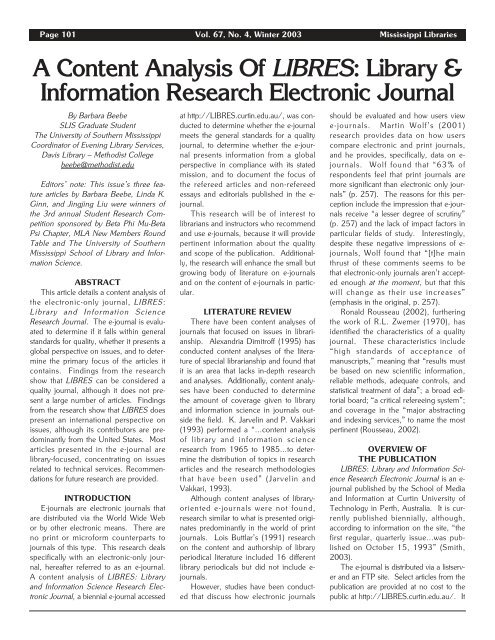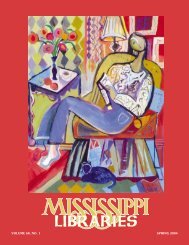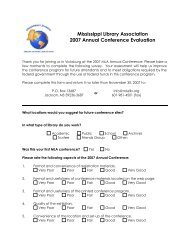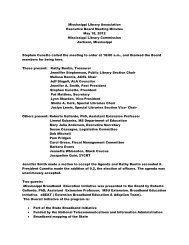Full Text (PDF) - Mississippi Library Association
Full Text (PDF) - Mississippi Library Association
Full Text (PDF) - Mississippi Library Association
You also want an ePaper? Increase the reach of your titles
YUMPU automatically turns print PDFs into web optimized ePapers that Google loves.
Page 101 Vol. 67, No. 4, Winter 2003 <strong>Mississippi</strong> Libraries<br />
A Content Analysis Of LIBRES: <strong>Library</strong> &<br />
Information Research Electronic Journal<br />
By Barbara Beebe<br />
SLIS Graduate Student<br />
The University of Southern <strong>Mississippi</strong><br />
Coordinator of Evening <strong>Library</strong> Services,<br />
Davis <strong>Library</strong> – Methodist College<br />
beebe@methodist.edu<br />
Editors’ note: This issue’s three feature<br />
articles by Barbara Beebe, Linda K.<br />
Ginn, and Jingjing Liu were winners of<br />
the 3rd annual Student Research Competition<br />
sponsored by Beta Phi Mu-Beta<br />
Psi Chapter, MLA New Members Round<br />
Table and The University of Southern<br />
<strong>Mississippi</strong> School of <strong>Library</strong> and Information<br />
Science.<br />
ABSTRACT<br />
This article details a content analysis of<br />
the electronic-only journal, LIBRES:<br />
<strong>Library</strong> and Information Science<br />
Research Journal. The e-journal is evaluated<br />
to determine if it falls within general<br />
standards for quality, whether it presents a<br />
global perspective on issues, and to determine<br />
the primary focus of the articles it<br />
contains. Findings from the research<br />
show that LIBRES can be considered a<br />
quality journal, although it does not present<br />
a large number of articles. Findings<br />
from the research show that LIBRES does<br />
present an international perspective on<br />
issues, although its contributors are predominantly<br />
from the United States. Most<br />
articles presented in the e-journal are<br />
library-focused, concentrating on issues<br />
related to technical services. Recommendations<br />
for future research are provided.<br />
INTRODUCTION<br />
E-journals are electronic journals that<br />
are distributed via the World Wide Web<br />
or by other electronic means. There are<br />
no print or microform counterparts to<br />
journals of this type. This research deals<br />
specifically with an electronic-only journal,<br />
hereafter referred to as an e-journal.<br />
A content analysis of LIBRES: <strong>Library</strong><br />
and Information Science Research Electronic<br />
Journal, a biennial e-journal accessed<br />
at http://LIBRES.curtin.edu.au/, was conducted<br />
to determine whether the e-journal<br />
meets the general standards for a quality<br />
journal, to determine whether the e-journal<br />
presents information from a global<br />
perspective in compliance with its stated<br />
mission, and to document the focus of<br />
the refereed articles and non-refereed<br />
essays and editorials published in the e-<br />
journal.<br />
This research will be of interest to<br />
librarians and instructors who recommend<br />
and use e-journals, because it will provide<br />
pertinent information about the quality<br />
and scope of the publication. Additionally,<br />
the research will enhance the small but<br />
growing body of literature on e-journals<br />
and on the content of e-journals in particular.<br />
LITERATURE REVIEW<br />
There have been content analyses of<br />
journals that focused on issues in librarianship.<br />
Alexandria Dimitroff (1995) has<br />
conducted content analyses of the literature<br />
of special librarianship and found that<br />
it is an area that lacks in-depth research<br />
and analyses. Additionally, content analyses<br />
have been conducted to determine<br />
the amount of coverage given to library<br />
and information science in journals outside<br />
the field. K. Jarvelin and P. Vakkari<br />
(1993) performed a “…content analysis<br />
of library and information science<br />
research from 1965 to 1985…to determine<br />
the distribution of topics in research<br />
articles and the research methodologies<br />
that have been used” (Jarvelin and<br />
Vakkari, 1993).<br />
Although content analyses of libraryoriented<br />
e-journals were not found,<br />
research similar to what is presented originates<br />
predominantly in the world of print<br />
journals. Lois Buttlar’s (1991) research<br />
on the content and authorship of library<br />
periodical literature included 16 different<br />
library periodicals but did not include e-<br />
journals.<br />
However, studies have been conducted<br />
that discuss how electronic journals<br />
should be evaluated and how users view<br />
e-journals. Martin Wolf’s (2001)<br />
research provides data on how users<br />
compare electronic and print journals,<br />
and he provides, specifically, data on e-<br />
journals. Wolf found that “63% of<br />
respondents feel that print journals are<br />
more significant than electronic only journals”<br />
(p. 257). The reasons for this perception<br />
include the impression that e-journals<br />
receive “a lesser degree of scrutiny”<br />
(p. 257) and the lack of impact factors in<br />
particular fields of study. Interestingly,<br />
despite these negative impressions of e-<br />
journals, Wolf found that “[t]he main<br />
thrust of these comments seems to be<br />
that electronic-only journals aren’t accepted<br />
enough at the moment, but that this<br />
will change as their use increases”<br />
(emphasis in the original, p. 257).<br />
Ronald Rousseau (2002), furthering<br />
the work of R.L. Zwemer (1970), has<br />
identified the characteristics of a quality<br />
journal. These characteristics include<br />
“high standards of acceptance of<br />
manuscripts,” meaning that “results must<br />
be based on new scientific information,<br />
reliable methods, adequate controls, and<br />
statistical treatment of data”; a broad editorial<br />
board; “a critical refereeing system”;<br />
and coverage in the “major abstracting<br />
and indexing services,” to name the most<br />
pertinent (Rousseau, 2002).<br />
OVERVIEW OF<br />
THE PUBLICATION<br />
LIBRES: <strong>Library</strong> and Information Science<br />
Research Electronic Journal is an e-<br />
journal published by the School of Media<br />
and Information at Curtin University of<br />
Technology in Perth, Australia. It is currently<br />
published biennially, although,<br />
according to information on the site, “the<br />
first regular, quarterly issue...was published<br />
on October 15, 1993” (Smith,<br />
2003).<br />
The e-journal is distributed via a listserver<br />
and an FTP site. Select articles from the<br />
publication are provided at no cost to the<br />
public at http://LIBRES.curtin.edu.au/. It














